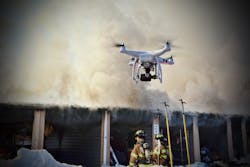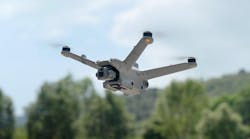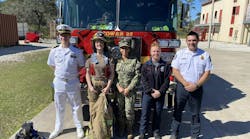In the April 2015 issue of Firehouse Magazine, I provided information as it relates to unmanned aircraft systems (UAS), the Federal Aviation Administration (FAA) requirements and how UAS will enhance situational awareness for incident commanders (ICs). At that time, the requirements for UAS operators were more stringent and restrictive for most public safety organizations.
Over the past year, I contacted at least eight public safety departments that received national news coverage for their use of UAS for a public safety purpose. Out of the eight, not one department was flying with the proper FAA authorization—and they did not realize that they were failing to meet the FAA rules. Without proper knowledge of the National Air Space (NAS), there are many opportunities for disastrous consequences.
Tracking changes
Over the past year, a number of requirements and provisions have changed in the area of UAS public aircraft operator requirements and FAA Certificate of Authorizations (COA). These changes make it easier for public safety compliance of FAA requirements for UAS, but also place a great deal of responsibility on public safety agencies. The FAA has been working with members of public safety and national public safety organizations to make several significant changes.
The first key change involves defining that public aircraft operations (PAO) fall under Title 49 of the United States Code (49 U.S.C.) §§ 40102(a)(41) and 40125. This essentially means that it operates as a governmental function. By the statute, governmental function is defined as “an activity undertaken by a government, such as national defense, intelligence missions, firefighting, search and rescue, law enforcement (including transport of prisoners, detainees, and illegal aliens), aeronautical research, or biological or geological resource management.”
An aircraft described above qualifies as a public aircraft as long as the aircraft is not used for commercial purposes and that it is owned or operated by the National Guard of a state, the District of Columbia, or any territory or possession of the United States. An exception to government ownership is outlined as follows:
Search and Rescue Purposes—An aircraft described in section United States Code (U.S.C.) 40102(a)(41)(D) that is not exclusively leased for at least 90 continuous days by the government of a State, the District of Columbia, or a territory or possession of the United States or a political subdivision of one of those governments qualifies as a public aircraft if the administrator determines ALL of the following:
(1) There are extraordinary circumstances;
(2) The aircraft will be used for the performance of search and rescue missions;
(3) A community would not otherwise have access to search and rescue services; and
(4) A government entity demonstrates that granting the waiver is necessary to prevent an undue economic burden on that government.
The requirement of a COA still remains an FAA requirement. A COA can only be acquired by a government entity (town, city, county, state, territory, tribal, etc.). This means that an individual public safety agency cannot apply for a COA without permission and “Declaration Letter” from the locality that it operates within. However, per a change regarding the COA, the FAA now issues a Blanket COA that allows for general operational provisions, which include:
- Under 400 feet above ground level (AGL)
- Distance from public use airport
o 5 nautical miles (NM) from an airport having an operational control tower; or
o 3 NM from an airport having a published instrument flight procedure, but not having an operational control tower; or
o 2 NM from an airport not having a published instrument flight procedure or an operational control tower; or
o 2 NM from a heliport.
- Cannot operate over people or near buildings unless adequate control by the emergency responders on scene to minimize risk
- Flight within visual line of sight (vlos) only
- Daytime flight only
- Flights are not limited by geographic region provided all of the other flying requirements are met
COAs that require different/specialized operations (night flight, beyond line of sight, etc.) other than those outlined in the Blanket COA require a separate COA defining these operations and must be submitted to the FAA for approval.
Another significant change is to the UAS operator and observer requirements. Originally, the FAA required either a pilot’s license or successful completion of flight ground school and a Class 2 medical physical. Currently, the FAA advises that public aircraft operations can self-certify airworthiness, pilot, aircrew (observer), maintenance personnel and training, as outlined in FAA document 8900.1 Volume 16 Unmanned Aircraft Systems, which states:
“FAA-Recognized Equivalent—An FAA recognition that a public agency may exercise its own internal processes regarding airworthiness and pilot, aircrew, and maintenance personnel certification and training; furthermore, the agency has determined that its UAS is capable of safe operation in the National Airspace System (NAS) when conducting public aircraft operations under Title 49 of the United States Code (49 U.S.C.) §§ 40102(a)(41) and 40125.”
This “self-certification” means that the locality/agency can establish what is required to certify their respective small UAS (sUAS) operators (remote pilot in command, aka RPIC). This creates a new level of concern and caution that accompanies the application of self-certification. This places all of the responsibility and liability on the governing body for every aspect of the UAS program, and requires that the appropriate personnel, time and resources be dedicated to establish how self-certification will be achieved, by whom and by what standard.
In order to ensure a legal, safe and effective UAS program, clear policies and procedures must be in place and cover airworthiness, operations, administration, training, operator proficiency, maintenance and documentation of all. While there are a variety of UAS flight training courses available, there currently is no “FAA-approved UAS curriculum.” However, I was involved in the first “UAVs for Emergency Responders” class taught at Piedmont Virginia Community College (PVCC) in May 2016. This curriculum development involved information from the FAA, a number of different public safety agencies, the National Incident Management System (NIMS) Incident Command procedures, the Virginia Department of Emergency Management, the Mid Atlantic Aviation Partnership (MAAP—one of the FAA’s six national UAS test sites), the Commonwealth of Virginia Unmanned Systems Commission, and the National Association of Search and Rescue. You can learn more about this curriculum on the PVCC website: www.pvcc.edu/pvcc-workforce-services-unmanned-aerial-systems
While UAS brings a great deal of value for situational awareness, it is incumbent on all public safety organizations to operate legally, safely and effectively. To accomplish all three you will need to have or consider the following:
- Knowledge of FAA air space, airport restrictions and temporary flight restrictions (TFR)
- Knowledge of current and predicted weather conditions that may affect the flight
- Approved COA for the locality or state by FAA with defined flight operations
- Government entity must own the aircraft (with the exceptions referenced)
- UAS operators/observers that meet the FAA requirements and ongoing proficiency training
- Policies/procedures for self-certification, operations, training, airworthiness, maintenance and documentation
- Knowledge of how to submit an FAA notice to airmen (NOTAM) for each UAS flight
- Knowledge of how to communicate with local airports
- Defined data format requirements and storage needs
- Air boss at incident to coordinate and de-conflict national airspace
- Command Staff knowledge of UAS operations/limitations
- UAS crash insurance (for repair following a crash)
- Liability insurance
- Transparency, addressing privacy issues, public education campaign
- Law enforcement has another set of requirements that it must follow
The latest changes occurred on Aug. 29, 2016, and involve the release of FAA Part 107 Rules for UAS commercial operator certification. This certification is generally applicable to commercial UAS operators. However, anyone, including public safety personnel, can take (and are recommended to take) the FAA sUAS Airmen’s Knowledge Test and become certified as an sUAS remote pilot in command.
There are some unique differences between Part 107 and Public Agency Self-Certification. One significant difference is that Part 107 does not require a visual observer. This may have a specific value in a situation where the need is great, the risk is minimal, and an observer is not immediately available.
Note: When operating as a UAS remote pilot in command, you must fly under public agency rules or Part 107 rules. In other words, an RPIC cannot pick and choose from both sets of guiding principles during a flight mission. More information on Part 107 Becoming a Pilot can be found at www.faa.gov/uas/getting_started/fly_for_work_business/becoming_a_pilot.
In sum
UAS technology has and continues to demonstrate its power to do great things for public safety and will literally and figuratively take public safety to new heights to see what could not be seen and provide information that will hopefully result in better situational awareness and ultimately better command decisions. Now it is up to public safety agencies to ensure that they are responsible flying partners in the National Air Space. Happy legal and safe flying!







